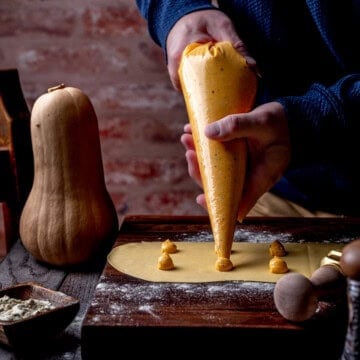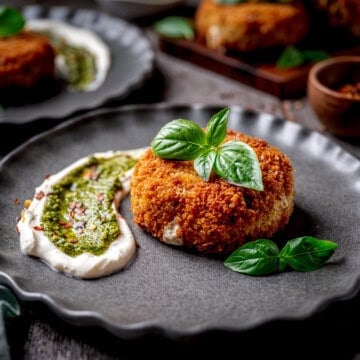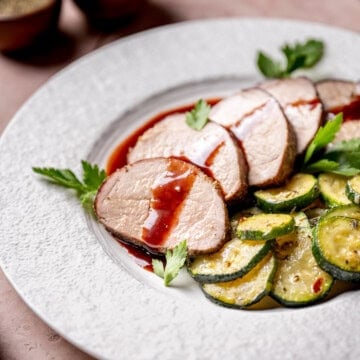Creamy polenta is a great alternative to more common starches we often use in the United States, like potatoes, rice and even pasta. We love Italian polenta and with some cheese and brown butter, it really comes to life! And there is no better complement to brown butter than sage. This Brown Butter and Sage Polenta recipe is heavenly and can be made into a main dish or a side dish with a number of things served with or on top of the polenta!

We love having polenta with roasts during the holiday season, but it is also delicious all year around!
Looking for more polenta recipes? Check out our recipes for Parmesan Polenta or Smoked Gouda and Porcini Mushroom Polenta.
Jump to:
- What is polenta?
- Ingredients
- Substitutions
- How to Make Brown Butter and Sage Polenta
- Step-by-Step Instructions for Brown Butter Sage Polenta
- Variations
- Storage
- What to Make with Leftover Polenta
- Top tip
- Troubleshooting
- What to serve with Brown Butter and Sage Polenta
- What wines pair with polenta?
- Looking for more Italian recipes?
- FAQ
- Related
- Pairing
- 📖 Recipe
- Food safety
What is polenta?
Polenta is actually the finished dish, not an ingredient. Polenta originates from Northern Italy. However, the main ingredient in polenta is a specific type of ground corn. Polenta is made simply of coarse cornmeal and is generally gluten free (check the package as some producers prepare their polenta on the same equipment as they grind wheat flour). It comes from flint corn grown in Italy, giving it a different texture and a different feel when cooked than cornmeal or grits. Although yellow polenta is more common, you can absolutely find the white variety as well. The yellow polenta variety will generally have more of a familiar “corn” taste to it than the white variety, but they are interchangeable.
Instant Polenta vs Regular Polenta
Polenta can also be found as “instant” or “classic,” the latter we refer to as regular polenta. Instant polenta has been par cooked and re-dried, so it shortens the preparation time at home dramatically. Instant polenta cooks in about 3 minutes, while classic polenta takes 30 minutes or longer and requires copious amounts of stirring. The bottom line is that the regular version tastes better when the dish is finished. However, it is harder to find at grocery stores and requires much more time to cook than the instant variety. We chose to use instant polenta in this recipe because it is easier to find.
Polenta vs Grits
Both grits and polenta are made from ground corn, but the corn used for each is a different variety. Polenta comes from flint corn, while grits come from dent corn. The grind on the corn is also different, with polenta corn being more uniform and flaky relative to the dent corn grits come from, which is irregular and usually coarser. Finally, dent corn (grits) has a bit more starch than flint corn (polenta) does, so if prepared the exact same way, grits will be slightly creamier.
Ingredients
Make this recipe for Brown Butter and Sage Polenta with the following ingredients:
- Instant Polenta: We used instant yellow polenta for this recipe since it is very easy to find in stores. You can use classic polenta to make this dish in nearly the same way, although it will need to cook longer.
- Vegetable Stock: We use low or no sodium vegetable stock for this recipe. Using this instead of water will add depth of flavor to the finished dish.
- Butter: Unsalted butter is used to make the brown butter that is a key component of this polenta. We also use a bit of whole butter as well to increase the creaminess at the end.
- Sage: A co-star of the dish, sage has that unmistakable warm flavor that elevates this polenta and pairs beautifully with the nuttiness of brown butter.
- Parmigiano Reggiano: A good quality, real Parmesan cheese is used here. Look for markings saying it is from Italy for the real deal Parmesan.
- Kosher Salt
- Fresh Ground Black Pepper
See recipe card below for quantities.

Substitutions
Here are a few common substitutions for the ingredients in this recipe:
- Vegetable Stock: You could certainly use water instead, although you will lose a little bit of flavor. If you are serving this with a protein, you could also use a different stock, such as chicken, beef, or even seafood or fish stock.
- Polenta: You can substitute grits for polenta. Although similar, they are not the same thing, but grits will work here if needed and it will still be a delicious dish.
- Parmesan: Other hard grating cheeses also work well, such as asiago or an aged pecorino (sheep's milk cheese).
- Brown Butter: If this delicacy isn’t your thing, you can use regular whole butter instead.
How to Make Brown Butter and Sage Polenta
This recipe is actually very quick and simple to make on the stove top. Just make your brown butter, polenta and mix everything in. That over-simplifies things, but it’s very close to what you have to do! Making brown butter doesn’t take long and neither does cooking polenta, assuming you’re using the instant variety.
Equipment
All the equipment you need is pretty common and straightforward:
- A small, shallow sauté pan or skillet to brown the butter.
- A medium pot to make the polenta
- A wooden spoon to stir the polenta
Step-by-Step Instructions for Brown Butter Sage Polenta
Step 1: Chop the Sage
- Chop the sage first, as you’ll need it as soon as the brown butter is ready.
Step 2: Make the Brown Butter
- In a shallow sauté pan or small skillet, cook the butter over medium heat until it begins to brown and smells nutty - about 5 minutes. Remove from heat and pour it in a small bowl making sure to get all of the browned bits. Add the sage to the brown butter at this point and stir.
Step 3: Make the Polenta
- In a medium to large saucepan, bring the vegetable stock to a boil. Remove from the heat and slowly stir in the polenta, ensuring you are constantly stirring. Stir for 2-3 minutes as it thickens.
Step 4: Finish the Polenta
- Add the brown butter and sage, and stir until incorporated. Then stir in the grated cheese, salt, and pepper until combined. Add the whole butter and stir in until incorporated. Transfer to a serving bowl and serve!

Variations
Here are some fun ways to change up this dish:
- Try different herbs! Other herbs work here as well, or you can omit them altogether. Try rosemary, thyme or oregano, they all work exceptionally well in this polenta dish. Fresh herbs work best.
- Turn up the heat! Make this dish spicy by adding crushed red pepper flakes.
- Add some cream. If you want a bit more rich and creaminess in this polenta dish, add a bit of cream at the end.
- Change the cheese. Use pecorino or asiago to change the taste of the final dish. You can use any hard grating cheese that you like for this dish.
Storage
How to store leftovers in the fridge:
There are a few good ways to do this, depending on how you want to cook your leftovers. Either way, let the polenta cool a bit before you do anything.
If you want to fry the leftovers, we suggest that you transfer polenta onto wax paper or parchment and form a log about 2-3 inches in diameter. Then wrap the whole thing in plastic wrap and store in the refrigerator for up to 5 days.
If you are going to reheat the polenta into the form used in this recipe (creamy polenta) then just let it cool and put it into a covered container in the fridge for up to 5 days.
Can you freeze polenta:
Yes you can. Store the polenta the same way as above shaped into a log but double wrap it and it will freeze for up to 3 months to use as fried polenta. Since we use instant polenta, we recommend making a fresh batch when you want to enjoy it in the creamy form.
How to reheat polenta:
If you are reheating to the creamy state, simply put everything in a saucepan and heat on low. The key is you’ll need to add a significant amount of liquid (either more vegetable stock or water) to help bring the dried-out polenta to a creamy consistency. It takes some time so be patient, but stir and add liquid until the lumps break down and it is creamy and hot again.
If you are going to fry crispy rounds, just slice the polenta log you made with the leftovers as thick as you wish. We like ⅓” if we are going to put some topping (like beef ragù, shrimp or tomatoes) on it or ½” if we are eating it plain or with a sauce. Then fry gently in a fry pan with enough oil to keep it from sticking. We recommend a nonstick skillet for reheating as polenta likes to stick to everything. Just brown on both sides over medium low to medium heat and add a little finishing salt to serve.
What to Make with Leftover Polenta
Eat creamy leftover polenta topped with just about anything or eat it plain. If you are making the crispy fried polenta type, the same concept applies. We love topping it with a tomato sauce, chopped tomatoes and basil, any sort of ragù, shrimp and pesto, etc.
Need some inspo? Check out our recipe for Butter Poached Shrimp and Pesto Polenta Bites.
Top tip
Taste your polenta for seasoning before serving. Polenta can take on quite a bit of salt, so make sure it is where you like.
Troubleshooting
Really, the only things that may need adjusting when making your polenta are consistency, seasoning and patience.
- Polenta too thick? If your polenta is too thick, just add some liquid. Polenta does what it wants to sometimes, so if it seems too thick when you make it, it will only get thicker, so add some more stock or water to loosen it to the consistency you prefer.
- Polenta under-seasoned? If it needs salt, add some.
- Allow the butter to incorporate. When incorporating the brown butter, it needs a little time to incorporate, so be patient and let it do its thing before adding more.
What to serve with Brown Butter and Sage Polenta
Polenta is the perfect comfort food and there are a number of things that work very well with this dish. Any deep-flavored ragù or stew over polenta is heavenly oven a bed of creamy polenta. Try out some of these options:
- Italian White Ragù with Veal and Pork (Ragù Bianco)
- Mushroom Ragù
- Pork and Shiitake Mushroom Ragù
- Beer Braised Short Ribs
Sausage and peppers is a fabulous accompaniment as well. And shrimp, or any seafood works very well also, but we’d recommend replacing the sage with something like thyme or parsley when doing seafood. Polenta is also great with vegetables - try some roasted green vegetable dish or mixed stewed vegetables. Just about anything goes with polenta so experiment!

What wines pair with polenta?
Polenta is definitely the base that can be topped with almost anything, so wine pairing should be tailored to what’s being served with the polenta. In this way it is similar to rice or pasta, as you pair wines with the accompaniment more than the grain or starch. For red meats, go for bold red wines like cabernet sauvignon, and for poultry and fish, dry white wine (pinot grigio or sauvignon blanc) is perfect.
If eating on its own, or looking to pair specifically with polenta, the pick is a bold chardonnay. Other choices that are fantastic pairings are merlot, pinot noir and Italian rosé.
Looking for more Italian recipes?
If you want more Italian recipes, you can find the classics under Classic Italian Recipes.
We also have a cookbook, Mangiamo. It includes 60 incredibly delicious Italian and Italian-inspired recipes.

FAQ
Yes, 100% of the time polenta should be gluten free since it is made from corn. However, read the label carefully for the disclaimer that it was processed using equipment that also processes wheat, as we’ve seen this on certain brands.
Generic “cornmeal” isn’t necessarily made with flint corn and isn’t ground the same way as polenta corn (i.e., flint corn). Again, polenta is the name of the dish, not the ingredient. However, you could make a polenta from coarse cornmeal (never make it with fine-ground cornmeal). It will differ slightly from true polenta in taste and texture, but it certainly will create a “porridge” just like polenta.
All of the ways described in this post are ways Italians eat polenta. The two most common ways are creamy (like this one) or fried, crispy polenta that can be in the shape of discs, cubes or irregular shapes. It can be grilled as well with great results!
Let’s talk about preference and tradition all at once. Traditionally, polenta is made with water. This allows the flavor of the corn to stand out more. So that’s tradition. Stock is used if you want that additional flavor (you can still taste the corn), but be sure to use a quality stock. We use homemade so we know exactly what is being added. We don’t like to use milk because, although it’s a liquid, it will very much thicken the polenta and can make it a bit pasty. It isn't recommended to use milk for the cooking liquid for the polenta, but it can be used to thin it out at the end if you don’t want to use water or stock.
Related
Looking for other recipes like this? Try these:
- Homemade Butternut Squash Ravioli Recipe
- Italian Herb Sautéed Zucchini Squash Recipe
- Garlic Herb Sautéed Italian Eggplant Recipe
- Pan Fried Risotto Cakes - Easy Leftover Risotto Recipe
Pairing
These are our favorite dishes to serve with this Brown Butter and Sage Polenta:
- Dry-Rubbed Roasted Pork Tenderloin Recipe
- Grilled Marinated Tri Tip Steak - Ultimate Marinade Recipe
- Crispy Sous Vide Pork Belly Bites with Ginger Soy Glaze
- Parmesan Crusted Filet Mignon with Truffle Cream Sauce
📖 Recipe

Brown Butter and Sage Polenta
Ingredients
- 6 large fresh sage leaves
- 8 Tablespoons unsalted butter divided
- 4 ½ cups vegetable stock - unsalted and high quality
- 9 oz Polenta-style instant cornmeal
- ¾ cup grated Parmesan cheese
- 2 teaspoon kosher salt
- ½ teaspoon black pepper
- Extra sage leaves to garnish optional
Instructions
- Chop the sage first, as you’ll need it as soon as the brown butter has been made. They don’t need to be finely chopped.
- Next make the brown butter. Place 6 tablespoons of butter in a small saucepan over medium heat. Cook until the milk solids in the butter brown and the aroma is nutty. Remove from the heat, place in a small bowl and add the sage to the brown butter. Set aside.
- Bring the stock to a boil. Once boiling, remove from the heat and, stirring constantly, slowly add the polenta. Do not add the polenta too quickly or it will become lumpy. Stir for 3 minutes, the polenta should be creamy. If it is very thick, thin it out with a little water or stock.
- Incorporate the brown butter and sage into the polenta by stirring. Be patient, it takes a minute or so. Stir in the cheese, salt, pepper, and remaining 2 tablespoons of butter until fully incorporated. Taste for additional seasoning. Serve!
Notes
Nutrition
Food safety
- Never leave cooking food unattended
- Always have good ventilation when using a gas stove













Angela says
The brown butter and sage flavors in this polenta really take it to another level!